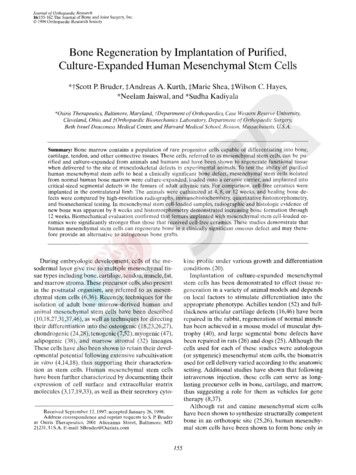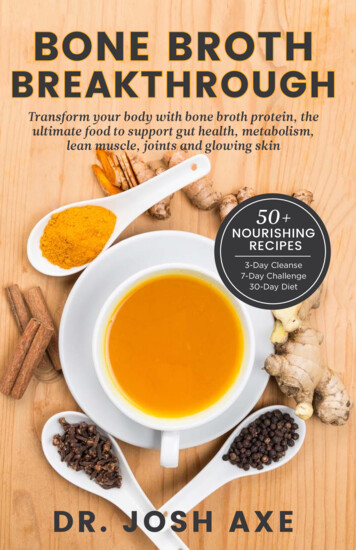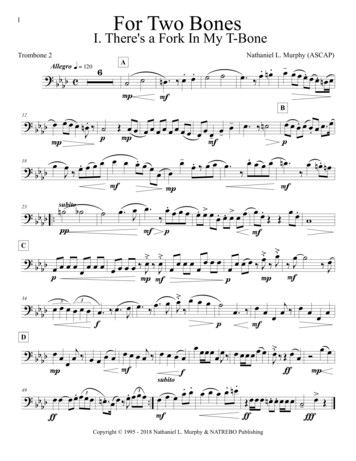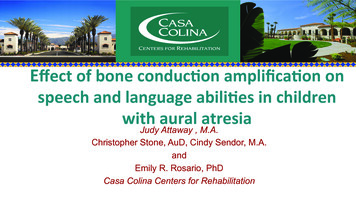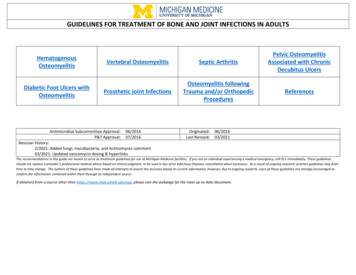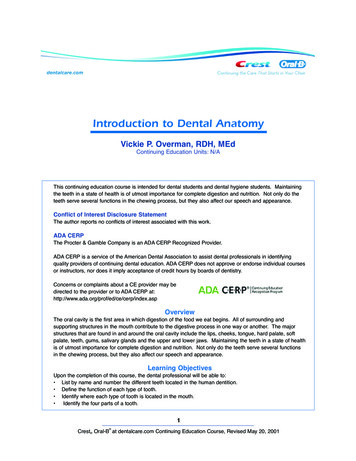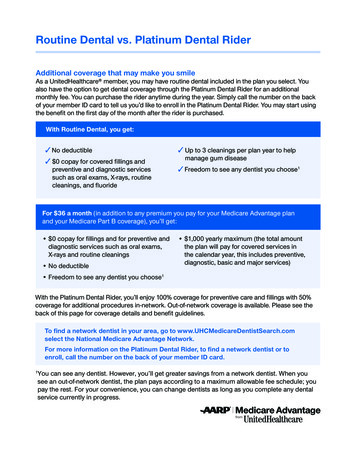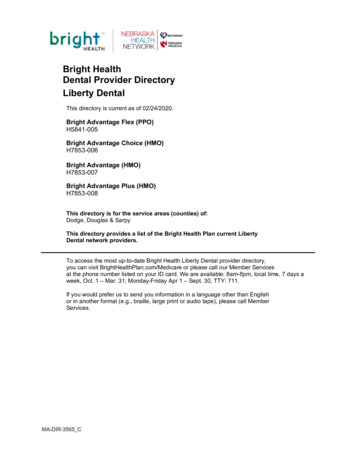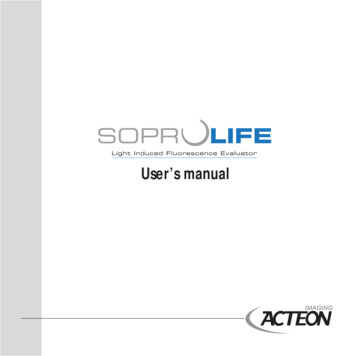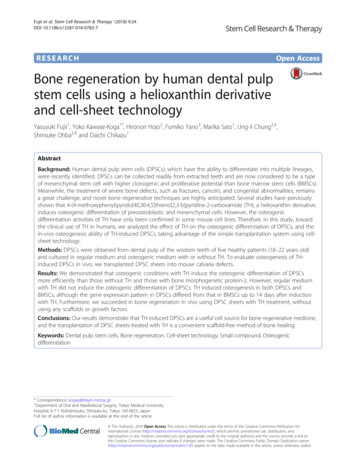
Transcription
Fujii et al. Stem Cell Research & Therapy (2018) 9:24DOI 10.1186/s13287-018-0783-7RESEARCHOpen AccessBone regeneration by human dental pulpstem cells using a helioxanthin derivativeand cell-sheet technologyYasuyuki Fujii1, Yoko Kawase-Koga1*, Hironori Hojo2, Fumiko Yano3, Marika Sato1, Ung-il Chung2,4,Shinsuke Ohba2,4 and Daichi Chikazu1AbstractBackground: Human dental pulp stem cells (DPSCs), which have the ability to differentiate into multiple lineages,were recently identified. DPSCs can be collected readily from extracted teeth and are now considered to be a typeof mesenchymal stem cell with higher clonogenic and proliferative potential than bone marrow stem cells (BMSCs).Meanwhile, the treatment of severe bone defects, such as fractures, cancers, and congenital abnormalities, remainsa great challenge, and novel bone regenerative techniques are highly anticipated. Several studies have previouslyshown that yridine-2-carboxamide (TH), a helioxanthin derivative,induces osteogenic differentiation of preosteoblastic and mesenchymal cells. However, the osteogenicdifferentiation activities of TH have only been confirmed in some mouse cell lines. Therefore, in this study, towardthe clinical use of TH in humans, we analyzed the effect of TH on the osteogenic differentiation of DPSCs, and thein-vivo osteogenesis ability of TH-induced DPSCs, taking advantage of the simple transplantation system using cellsheet technology.Methods: DPSCs were obtained from dental pulp of the wisdom teeth of five healthy patients (18–22 years old)and cultured in regular medium and osteogenic medium with or without TH. To evaluate osteogenesis of THinduced DPSCs in vivo, we transplanted DPSC sheets into mouse calvaria defects.Results: We demonstrated that osteogenic conditions with TH induce the osteogenic differentiation of DPSCsmore efficiently than those without TH and those with bone morphogenetic protein-2. However, regular mediumwith TH did not induce the osteogenic differentiation of DPSCs. TH induced osteogenesis in both DPSCs andBMSCs, although the gene expression pattern in DPSCs differed from that in BMSCs up to 14 days after inductionwith TH. Furthermore, we succeeded in bone regeneration in vivo using DPSC sheets with TH treatment, withoutusing any scaffolds or growth factors.Conclusions: Our results demonstrate that TH-induced DPSCs are a useful cell source for bone regenerative medicine,and the transplantation of DPSC sheets treated with TH is a convenient scaffold-free method of bone healing.Keywords: Dental pulp stem cells, Bone regeneration, Cell-sheet technology, Small compound, Osteogenicdifferentiation* Correspondence: kogay@tokyo-med.ac.jp1Department of Oral and Maxillofacial Surgery, Tokyo Medical UniversityHospital, 6-7-1 Nishishinjuku, Shinjuku-ku, Tokyo 160-0023, JapanFull list of author information is available at the end of the article The Author(s). 2018 Open Access This article is distributed under the terms of the Creative Commons Attribution 4.0International License (http://creativecommons.org/licenses/by/4.0/), which permits unrestricted use, distribution, andreproduction in any medium, provided you give appropriate credit to the original author(s) and the source, provide a link tothe Creative Commons license, and indicate if changes were made. The Creative Commons Public Domain Dedication o/1.0/) applies to the data made available in this article, unless otherwise stated.
Fujii et al. Stem Cell Research & Therapy (2018) 9:24BackgroundCurrent cell-based therapies are in need of alternativetreatment techniques that enable cells to be readilyharvested. Recently, dental pulp stem cells (DPSCs)were identified, which were found to differentiate intomultiple cell lineages, such as adipogenic, neurogenic,and osteogenic cells [1–3]. DPSCs are now consideredto be a type of mesenchymal stem cell (MSC) anddemonstrate higher clonogenic and proliferative potential than bone marrow stem cells (BMSCs). Compared with other MSCs, such as BMSCs, DPSCs arevery easily isolated from extracted teeth by lowinvasive surgery without any ethical issues. Therefore,DPSCs are a promising cell source for regenerativemedicine and tissue engineering.Current treatment methods are unable to fully reconstruct bone defects that are caused by fractures,cancers, congenital abnormalities, and so forth. Atpresent, autogenous or allogeneic bones and artificial materials are used for bone augmentation. However, there are various problems with these grafts,such as the possibility of infection or absorption aswell as ethical issues. To overcome such problems,a more simple and efficient method for transplantation is urgently required. Recently, cell-sheet engineering has emerged as a cell-transplantationsystem that requires no scaffolds or carriers, andhas been used for regenerative treatment of the cornea, heart, liver, and so forth [4–6]. Cell sheets canbe easily isolated by reducing the temperature of viable cells cultured on the temperature-responsiveculture dish surface, with no requirement of digestive enzymes or denaturing treatments [7]. Moreover,for cell-based therapies in regenerative medicine,optimization of the culture conditions regardingproliferation and differentiation is required. Recombinant proteins, such as bone morphogenic protein(BMP), are used clinically to induce new bone formation, and BMPs were reported to have the capacity of osteogenic induction in primary humanBMSCs [8]. However, recombinant proteins are expensive and unstable. Furthermore, BMPs play important roles not only in bone formation but also inthe development of cancer [9]. In contrast, severalstudies have shown that small chemical compoundsinduce bone formation. For example, statins [10],TAK-778 [11], and isoflavone derivatives [12] werereported to stimulate osteogenic differentiation, andwe reported previously the helioxanthin no[2,3b]pyridine-2-carboxamide (TH) to be a small molecule that induces osteogenic differentiation of preosteoblastic cells and mesenchymal cells in vitro[13, 14]. However, the osteogenic differentiationPage 2 of 12activities of TH were confirmed only in specific celllines, such as C3H10T1/2 cells and MC3T3-E1 cells,and these effects on human primary cells remainunknown.Based on these findings, we hypothesized thatDPSCs are sufficiently responsive to TH for osteogenic differentiation, and the combination of cellsheet engineering and TH-induced DPSCs would be asimple and convenient method for clinical applicationto bone regenerative medicine. Therefore, in thepresent study, we analyzed the effect of TH on theosteogenic differentiation of DPSCs in vitro and theosteogenesis of TH-induced DPSC sheets in vivo.MethodsCell isolation and cultureThis study was performed after receiving writtenconsent from all patients and was approved by theinstitutional ethics committee of the Faculty ofMedicine, Tokyo Medical University, Japan (approvalno. 2818). DPSCs were obtained from dental pulp ofthe wisdom teeth of five healthy patients (18–22years old) at Tokyo Medical University Hospital.The dental pulp was digested in a solution containing 3 mg/ml collagenase type I (Sigma-Aldrich) for45 min at 37 C, and single-cell suspensions wereobtained by passing the cells through a 70-μm cellstrainer. Human BMSCs were obtained from TakaraShuzo (C12974). The cells were seeded onto 100mm dishes at a density of 1 105 cells and culturedin alpha modification of Eagle’s medium (αMEM;Gibco/BRL) supplemented with 15% fetal bovineserum (FBS; Biowest) and 1% penicillin/streptomycin(P/S; Wako Pure Chemical Industries). All experiments were performed with DPSCs at passage 3(P3) or P4, and with BMSCs at P4. Cells were cultured in 12-well plates (BD, Franklin Lakes, NJ,USA) and 12-well Upcell (Cell Seed) in osteogenicconditions with or without TH. For osteogenic induction, cells were cultured in αMEM containing10% FBS, 1% P/S, 10 nM dexamethasone (Dex; WakoPureChemicalIndustries),10mMβglycerophosphate (β-GP; Sigma-Aldrich), and 100 μML-ascorbate-2-phosphate (AsAp; Wako Pure ChemicalIndustries) (osteogenic medium (OM)). TH, whichwas provided by Takeda Chemical Industries (Osaka,Japan), was dissolved in DMSO and added to OM orregular medium (RM) (Dulbecco’s modified Eagle’smedium (DMEM; Gibco/BRL) supplemented with10% FBS and 1% P/S). For osteogenic induction withBMP, recombinant human bone morphogenic protein2 (rhBMP-2; Peprotech) was added to the OM(300 ng/ml).
Fujii et al. Stem Cell Research & Therapy (2018) 9:24Flow cytometry analysisCells isolated from cultured DPSCs were suspended with0.25% trypsin, washed with phosphate-buffered saline(PBS), triturated into single cells, and filtered through a70-μm cell strainer. After suspension, cells were blockedwith 10% FBS for 10 min at 37 C, and incubated withfluorescein isothiocyanate (FITC)-conjugated antihuman CD14, FITC-human CD34, FITC-humanCD44, FITC-human CD81, phycoerythrin (PE)-conjugated human CD90, and FITC-human CD105 antibodies (BioLegend) for 90 min at 4 C. Cells werethen washed, and fixed in 4% paraformaldehyde(PFA) for 10 min at 4 C. Cells that were not treatedwith fluorescent antibodies were used as controls.The cell surface expression of markers was assessedusing a FACS Verse flow cytometer (BD Biosciences). Data were analyzed using the FACS software(FlowJo; FlowJo, LLC).Alizarin Red S stainingCells were rinsed twice with Ca2 -free PBS and fixed in10% formaldehyde in PBS for 10 min at 4 C. After twowashes with distilled water, the cells were stained in 1%Alizarin Red S (Sigma-Aldrich) solution for 15 min atroom temperature. The remaining dye was washed outby two washes with distilled water.Alkaline phosphatase stainingAlkaline phosphatase (ALP) staining was performedas described previously [15]. Briefly, the cells wererinsed with PBS, fixed in 70% ethanol, and stainedfor 10 min with 0.01% naphthol AS-MX phosphate(Sigma-Aldrich), using 1% N,N-dimethyl formamide(Wako Pure Chemical Industries) as the substrateand 0.06% Fast BB salt (Sigma-Aldrich) as a coupler.Cell proliferation and viabilityCell proliferation was analyzed using Cell Counting Kit8 (Dojindo). Cells were seeded at 1 103 cells per well in96-well plates and cultured with or without TH (10–8–10–5 M). After 72 h the labeling mixture was added tothe cells, and cells were incubated for 2 h in a 37 C/5%CO2 incubator. The spectrophotometric absorbance ofthe samples was measured using a microtiter platereader at a wavelength of 450 nm.Page 3 of 12under the following conditions: 95 C for 60 sec andthen 45 PCR cycles at 95 C for 10 sec, 65 C for30 sec, and 72 C for 45 sec. To normalize for differences in the amount of total RNA added to eachreaction, GAPDH was used as the endogenous control. The primer sequences used are presented inTable 1.Transplantation of DPSC sheetsAnimal experiments were performed according to aprotocol approved by the Animal Care and Usecommittee of the Faculty of Medicine, Tokyo Medical University. Six to eight-week-old maleNOD.CB17-Prkdcscid/J (NOD SCID) mice (OrientalYeast) were used. Five mice were used for each experimental group. Each mouse was anesthetizedwith medetomidine (0.75 mg/kg), midazolam(4.0 mg/kg), and butorphanol tartrate (5.0 mg/ml)via intraperitoneal injection. The skin and the subcutaneous layer were incised, and the calvaria wereexposed. Nonhealing and critical-sized (diameter3.5 mm) calvarial defects were created in the leftparietal bone using 3.5-mm disposable biopsypunches (Kai Corporation) [16]. One defect per animal was created. DPSCs were cultured ontemperature-responsive dishes in OM with or without TH treatment for 14 days. DPSC sheets wereharvested by incubation at room temperature for30 min, and transplanted into these defects. Theskin and subcutaneous layer were then closed by 60 nylon sutures. Eight weeks after surgery, calvariaswere harvested from euthanized mice.Radiological analysesMicro-CT scanning was performed using a microfocus X-rayCT system (SMX-90CT; Shimadzu) under the following conditions: tube voltage, 90 kV; tube current, 110 μA; and fieldof view (XY), 10 mm. The resolution of one CT slice was512 512 pixels. The three-dimensional constructionTable 1 Sequence information of primers used for quantitativereal-time polymerase chain reactionGenePrimer sequences (forward and reverse, GGATTTCRunx2Real-time polymerase chain reaction analysisTotal RNA was extracted using Trizol (Invitrogen)and reverse transcription was performed using theQuantiTect Reverse Transcription kit (Qiagen) according to the manufacturer’s instructions. Realtime polymerase chain reaction (RT-PCR) was performed in a Light Cycler 96 (Roche Diagnostics)using THUNDERBIRD SYBR qPCR Mix CAGCGAGGTAGTGAAGAGAGCAGAGCGACACCCTAGAC
Fujii et al. Stem Cell Research & Therapy (2018) 9:24Page 4 of 12Fig. 1 Flow cytometric analysis of DPSCs. DPSCs were cultured at P3 or P4, and surface-stained with FITC-conjugated CD14, CD34, CD44, CD81, and CD105and PE-conjugated CD90. Fluorescent signals were measured by flow cytometric analysis. Black curve represents control cells, red curve represents cells positivefor these markerssoftware package TRI/3D-BON (Ratoc System Engineering)was used for bone morphometric analysis. Bone volume(BV), bone mineral content (BMC), and bone mineral density (BMD) were calculated within a 5 5 3-mm3 cuboidarea, in which the circular defect was adjusted to be at thecenter.diaminetetraacetic acid (EDTA) solution under gentle shaking for 1 week. Decalcified samples were embedded in paraffin and cut into 5-μm thick sections. Sections weredeparaffinized and subjected to hematoxylin and eosin staining and Masson trichrome staining. Sections were observedunder a microscope (BZX700; Keyence).Histological analysisStatistical analysisFor sectioning, mouse calvaria were fixed in 4% PFA/PBSovernight, and decalcified using 10% ethylene-Data were reported as mean standard deviation (SD).Statistical significance was evaluated using ANOVA and
Fujii et al. Stem Cell Research & Therapy (2018) 9:24the Student t test for comparison using SPSS 24.0 software(IBM). p 0.05 was considered to indicate a statistically significant difference between two groups.ResultsCharacterization of DPSCsTo characterize the proportion of DPSCs under ourculture conditions, we analyzed the expression ofsurface markers by flow cytometry. The cells werepositive for CD44, CD81, CD90, and CD105, butnegative for the hematopoietic stem cell makersCD14 and CD34 (Fig. 1). These data are in accordancewith previous studies of DPSC surface expression [3, 17].Page 5 of 12Optimal concentration of TH for the osteogenicdifferentiation of DPSCsTo analyze the osteogenic effect of TH in DPSCs,we cultured DPSCs in RM and OM with TH at concentrations ranging from 10–8 to 10–5 M for 21 days.Osteogenic differentiation was evaluated by matrixmineralization visualized by Alizarin Red staining.Although TH induced no mineralization in DPSCscultured in RM, TH at 10–6 M was found to induce moreextensive calcification of DPSCs cultured in OM thanat the other concentrations tested (Fig. 2a). TH at10–5 M suppressed matrix mineralization of DPSCs inOM compared with TH at 10–6 M. We also analyzed theFig. 2 Optimal concentration of TH for inducing osteogenic differentiation of DPSCs. a DPSCs cultured in OM or RM with or without TH at concentrationsranging from 10–8 to 10–5 M. After 21 days, cells were stained with Alizarin Red S to detect matrix mineralization (n 5). b After incubation for 72 h,proliferation rates of DPSCs in presence or absence of TH were determined using Cell Counting Kit (n 5). c After treatment as in (a), RT-PCR performed tomeasure the expression levels of osteogenic differentiation makers in DPSCs (n 5). Error bars represent SD. Statistical significance determined by one-wayANOVA (*p 0.05). TH yridine-2-carboxamide, OM osteogenic medium, RM regular medium
Fujii et al. Stem Cell Research & Therapy (2018) 9:24effect of various concentrations of TH on gene expressions of Runx2, an osteoprogenitor maker, Alpand Type I collagen alpha 1 (ColIa1), early markersof osteoblast differentiation, and osteocalcin, a mature osteoblast marker, by RT-PCR. Although there wereno statistically significant differences in the expressionlevels of Runx2, Alp, and ColIa1, OM with TH at 10–6 Msignificantly upregulated osteocalcin expression compared with RM alone and RM with TH at 10–6 M(Fig. 2b). To analyze the effect of various concentrations ofTH on the proliferation and viability of DPSCs, we used acolorimetric assay for cell proliferation. TH at 10–5 M tendedPage 6 of 12to suppress cell proliferation; however, there were no significant differences in proliferation rates between RM andOM with or without TH (Fig. 2c). These data suggest thatTH induces the osteogenic differentiation of DPSCs cultured in OM and the optimal concentration of TH for theosteogenesis of DPSCs is approximately 10–6 M.Osteogenic differentiation of DPSCs by short-term culturewith THWe next analyzed the effects of TH for the osteogenic differentiation of DPSCs within a short time. ALP stainingshowed that TH tended to upregulate and enhance ALPFig. 3 Osteogenic differentiation of DPSCs with TH in short-term culture. a DPSCs cultured in OM with or without TH (10–6 M). After 7 or 14 days,cells were subjected to ALP staining to detect ALP activity (n 4). b RT-PCR performed to measure expression levels of osteogenic differentiationmarkers in DPSCs cultured with or without TH at day 7 or day 14. Gene expression levels of each sample plotted in the left graph, and the rightgraph shows the means of four samples. Error bars represent SD. Statistical significance determined by paired Student t test (*p 0.05). d day, OMosteogenic medium, TH yridine-2-carboxamide
Fujii et al. Stem Cell Research & Therapy (2018) 9:24activity of DPSCs at day 7 and day 14 in all samples (Fig. 3a).RT-PCR showed that TH significantly upregulated the expression of Alp and ColIa1at day 7, and osteocalcin was significantly upregulated by TH at day 14. However, TH didnot induce Runx2 mRNA expression at day 7 and day 14.These results are generally consistent with the results ofALP staining and indicate that TH exerts positive effects onthe osteogenic differentiation of DPSCs, and its osteogeniceffects begin earlier than under conventional osteogenic culture conditions.Page 7 of 12Comparison of the osteogenic differentiation ability ofDPSCs and BMSCs in the presence of THTo demonstrate the usefulness of TH-induced DPSCs,we compared osteogenic induction abilities betweenDPSCs and BMSCs in the presence of TH. ALP stainingshowed that TH enhanced ALP activity in both DPSCsand BMSCs at 14 days (Fig. 4a). RT-PCR analysesshowed that TH-induced BMSCs had significantlyhigher expression levels of Alp on day 7 and day 14compared with TH-induced DPSCs (Fig. 4b). In contrast,Fig. 4 Comparison of osteogenic differentiation ability of DPSCs and BMSCs in the presence of TH. a DPSCs and BMSCs cultured in OM with or withoutTH (10–6 M). After 7 or 14 days, cells were subjected to ALP staining to detect ALP activity. b RT-PCR performed to measure the expression levels ofosteogenic differentiation markers in DPSCs and BMSCs cultured with or without TH at day 7 or day 14. Error bars represent SD. Statistical analysesperformed by one-way ANOVA (*p 0.05, **p 0.01). Results of DPSCs are from four patients. Results of BMSCs are from three independent experiments. dday, DPSC human dental pu
ences). Data were analyzed using the FACS software (FlowJo; FlowJo, LLC). Alizarin Red S staining Cells were rinsed twice with Ca2 -free PBS and fixed in 10% formaldehyde in PBS for 10 min at 4 C. After two washes with distilled water, the cells were stained in 1% Alizarin Red S
